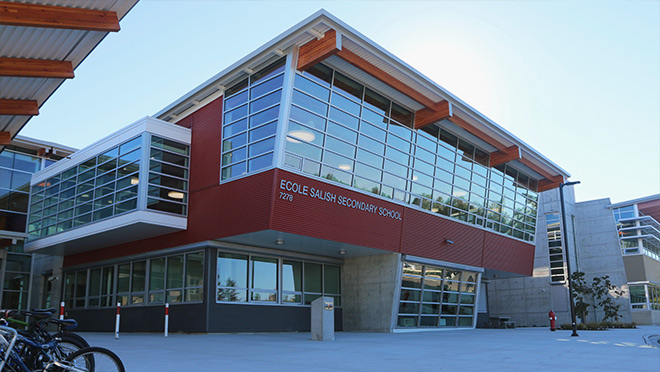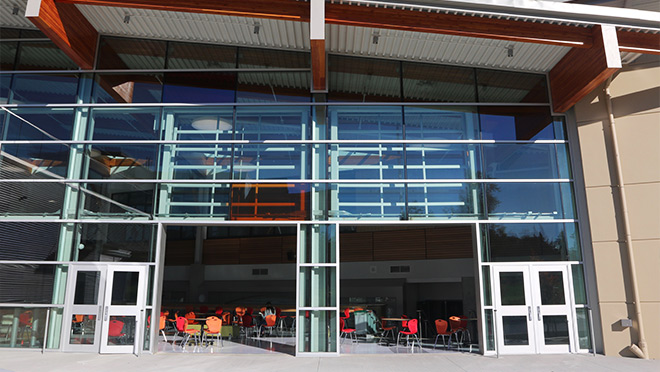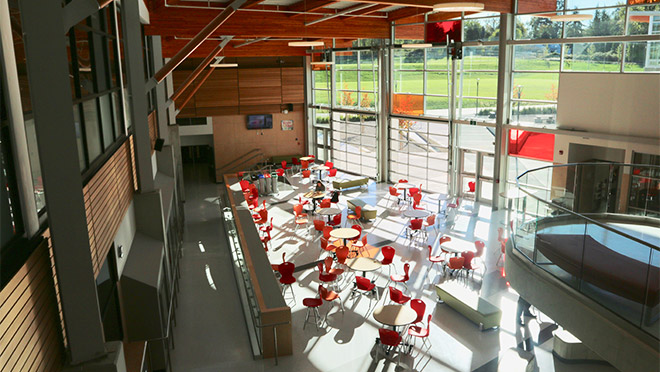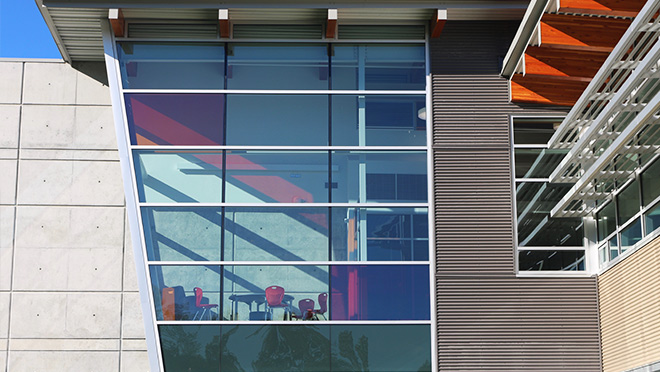Salish Secondary School delivers a futuristic lesson in energy efficiency

A new school for a new curriculum
As one of the fastest growing cities in Canada, it's no surprise that the demand for new schools in Surrey is so high. Projected to become the biggest city in B.C. by 2041, there are 44,000 new residences expected over the next decade, adding approximately 10,000 additional students.
With 15 school projects reportedly in the design phase, Surrey Schools gave us an exciting view of the future with Salish Secondary, which opened in September 2018. One of the first schools to be designed to support the new curriculum, it features huge collaborative spaces that can be partitioned off with sliding glass walls, an open air rooftop yoga studio, and whiteboard desks. And as you'd expect, it's also packed with state-of-the-art technology, including a theatre, WiFi, and huge screens for students to project work onto.
With so many schools planned in the near future, a huge evolution in learning taking place, and students needing to power as many as 3 devices every day, Salish not only needed to lead the way for education, but also for energy efficiency.

Big goals for 2020
Surrey Schools has reduced emissions by 19% since 2010. Its goal is to get that 2010 baseline down by 25% in 2020. With all new schools required to strive for LEED® Gold standards of efficiency, these goals have inspired some future-facing features for Salish Secondary, such as:
- Hybrid heating system with air source heat pumps, paired with condensing boilers to allow the equipment to operate at the optimal efficiency under all operating conditions.
- Argon-filled windows with warm-edge spacers – critical for a building with so many windows and large, open areas. Argon-filled windows drastically reduce solar heat gain and loss. In addition to this, the warm edge spacers further reduce the amount of heat loss transfer where the windows connect to the building. This contributes to a highly efficient building envelope that minimizes the need for mechanical heating and cooling.
- 100% LED lighting throughout the entire building from the theatre to the parking lot is a first as well. LED popularity has grown rapidly over the last few years, but in 2016, when Salish Secondary was designed, this was a bold move and Salish was Surrey's first school to be designed specifically for LED.

Sharing knowledge and saving energy
Designing a school around the new, highly collaborative curriculum required a highly collaborative planning, design and construction approach. Educators were heavily involved to envision their ideal learning environments and facilities managers brought their expertise on a huge range of critical features, from custodial room size to safe roof access.
BC Hydro's Commercial New Construction Program helped to keep a tight focus on energy efficiency throughout. "Budgets are always a primary concern," says Tracy Blagdon, Energy Manager with Surrey Schools. "So it would've been challenging to make the case for spending money on energy modelling. But BC Hydro's incentive really opened the door to make that happen. Based on that energy study, we were then able to see which energy efficient measures had good energy savings, and a strong payback to them. We were actually able to say, ‘this is going to save X amount of energy, or reduce our greenhouse gas emissions by Y', and ultimately, secure funding for them."
In addition to this, with so many schools under construction, a lot of solutions are generated, so BC Hydro also facilitates ongoing monthly calls between Energy Managers from 12 different school districts. "Our engineers can showcase beneficial ideas, and share those with school districts. However, we're also careful, because each school district is unique." says Cory Farquharson, Key Account Manager at BC Hydro.

The future of learning
Looking back across the project, Tracy is a big advocate for carefully selecting construction partners when you're prioritizing energy efficiency: "Partners really have to be aware of how things are changing and which leading edge options to trust. At occupancy, you need to know you've got a product that is energy efficient, but is also going to work as the design intended, because with over 1,000 students and staff using this building, you can't justify sacrificing the comfort of those people for energy efficiency."
While the pressure on Surrey to create so many new schools is intense, Cory can see it's not just the students who are learning: "Surrey is innovative in proactively learning from past projects. They're looking at them and seeing what worked from an operational, maintenance and construction standpoint, and seeing how to replicate that into future buildings."
While it's still way too early to review operational data, the effect of all this on the staff and students of Salish Secondary has been immediately evident since opening day, according to Principal Sheila Hammond: "Things are going well and I'm getting good feedback from students. Everyone loves the natural light. It appears to be making a difference in terms of how happy everyone is coming into the school every day."